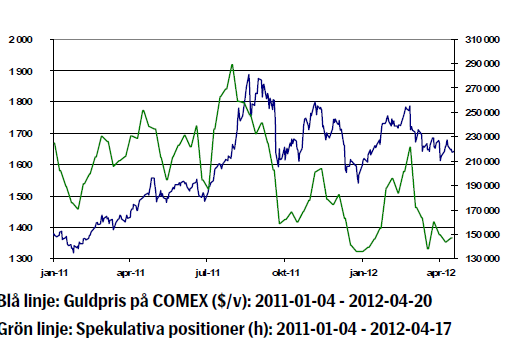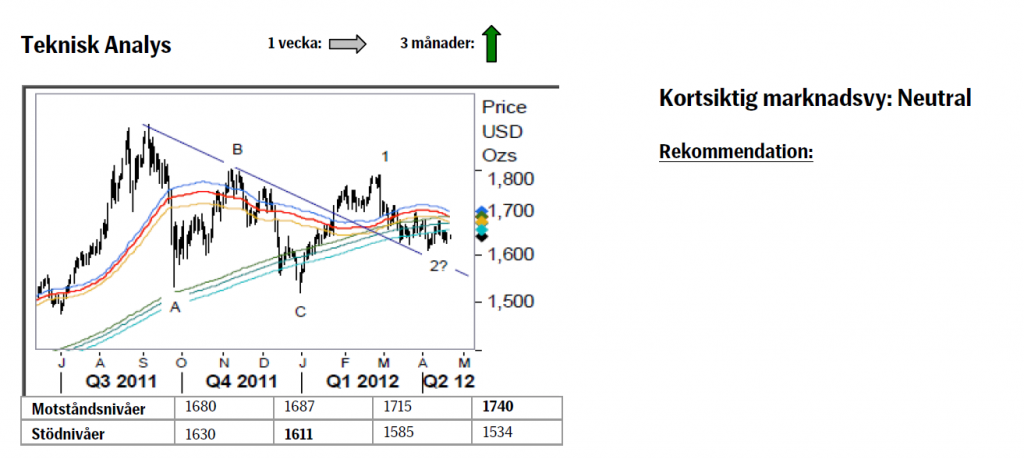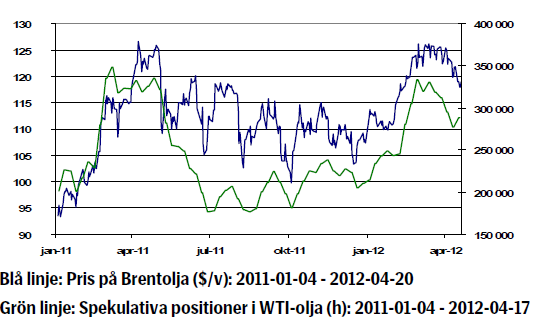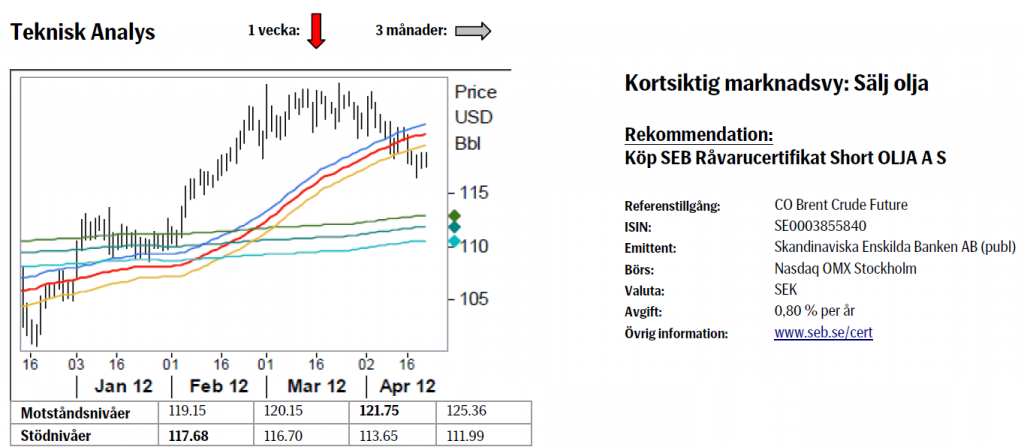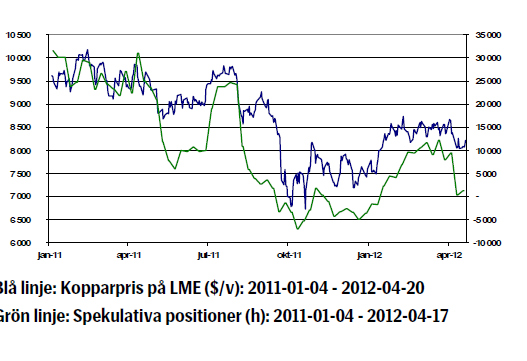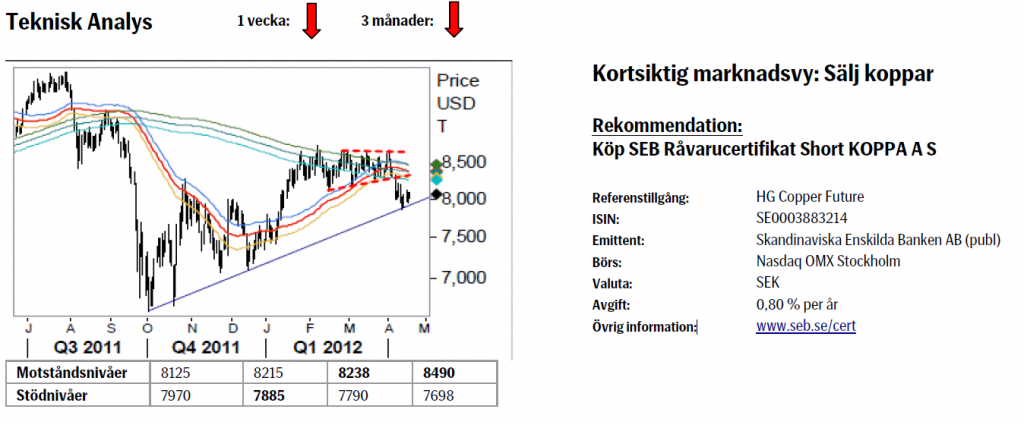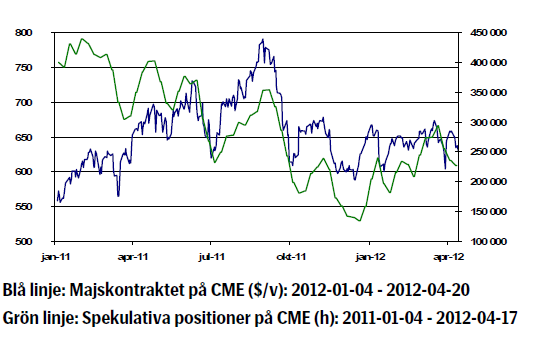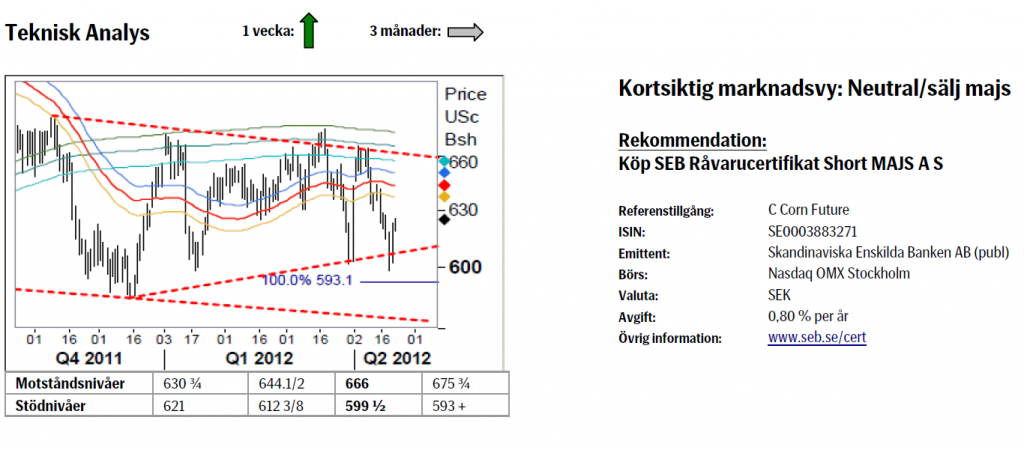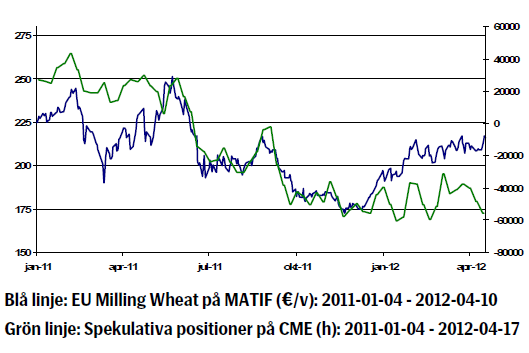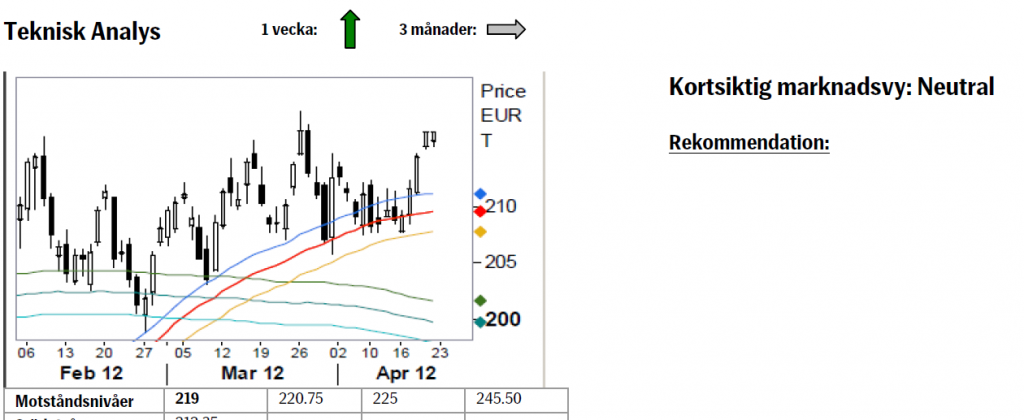Analys
SEB – Råvarukommentarer vecka 17 2012
Sammanfattning: Föregående vecka
 Brett råvaruindex: +0,33 %
Brett råvaruindex: +0,33 %
UBS Bloomberg CMCI TR Index- Energi: +0,37 %
UBS Bloomberg CMCI Energy TR Index - Ädelmetaller: -0,15 %
UBS Bloomberg CMCI Precious Metals TR Index - Industrimetaller: +1,75 %
UBS Bloomberg CMCI Industrial Metals TR Index - Jordbruk: +0,14 %
UBS Bloomberg CMCI Agriculture TR Index
Kortsiktig marknadsvy:
- Guld: Neutral
- Olja: Sälj
- Koppar: Sälj
- Majs: Neutral/sälj
- Vete: Neutral
Guld
- Guldpriset föll 0,4 procent förra veckan. Under veckan låg fokus på spanska obligationsemissioner, spansk 10-års ränta steg igen över 6 procent.
- Utvecklingen i Spanien är problematisk. Landet tyngs av stigande räntor, problem att få ner det offentliga underskottet och eventuella ytterligare behov att stötta banker.
- Det krävs besparingar vilka riskerar en ännu sämre ekonomisk utveckling som följd.
- Öppna positioner i terminskontrakt på Comex föll veckan som gick vilket grafen till vänster visar men fysiska guld ETF: er såg inga större in eller utflöden och världens största guld ETF SPDR har inte haft utflöden under veckan.
- Efterfrågan på guld i Indien kommer sannolikt att öka i samband med veckans festival ”Akshaya Tritya”.
- På onsdag riktas blickarna mot USA och räntebesked från FOMC. Indikationer på ytterligare QE3 kommer att ha stor betydelse för guldprisets utveckling.
- Teknisk Analys: Efter ett försök upp i medelvärdesbanden har vi under inne-varande vecka åter drivit ned under dessa. Detta är dock ännu ingen fara på taket och vi vidhåller att en potentiell lågpunkt har passerats så länge vi inte faller under 1611. En uppgång och framför allt en stängning över 1680 skulle vara klart positivt för vår positiva vy,
Olja
- Oljepriset steg åter på fredagen och det prisfall vi sett i början av veckan återhämtades och priset stängde oförändrat jämfört med föregående vecka.
- Oron kring Iran och landets atomenergiprogram har minskat efter förra helgen då västländer mötte Iran för samtal som beskrevs ha varit ”konstruktiva”.
- Irans oljeminister uttalade emellertid förra veckan att Iran kommer att sluta exportera till Europa om inte nästa möte i Bagdad, den 23 maj, blir ”positivt”.
- Europa har redan beslutat om ett totalförbud mot import av iransk olja från den först juli och många oljebolag har förberett sig på förbudet genom att leta substitut från bland annat Saudiarabien och Förenade Arabemiraten.
- Tisdagens APIs oljestatistik visare att råoljelagersteg steg med 3,4 miljoner fat. DOE data på onsdagen visade att råoljelager steg med 3,9 miljoner fat.
- Enligt Bloomberg News räknar 17 av 30 analytiker med sjunkande oljepriser
- Teknisk Analys: I och med nedgången under 55dagars bandet har vi övergivit vår medelsiktigt positiva vy och anser att sannolikheten för att få se den sista (?) uppgången till 129- 131 nu måste betraktas som låg. Ett återtest av 55dagars bandet för att prova validiteten i brottet ligger i korten för nästkommande vecka. Vi tror att man ska sälja en sådan reaktion till 120/122.
Koppar
- Kopparpriset steg 2,7 procent förra veckan.
- HSBC:s inköpschefsindex för Kina visade 49.1 för april. Det var en ökning från förra månadens siffra, 48.3, men det är samtidigt den sjätte månaden i rad som indexet hamnar under 50-nivån (som innebär att fler ser försämring än förbättring).
- Man har sett att fastighetspriser i 37 av 70 städer i Kina föll nio procent på årlig basis i mars vilket kan tyda på en viss nedkylning i landets ekonomi. Kinesiska myndigheter har uttryckt en önskan att se lägre fastighetspriser.
- Kinas import av koppar har varit stadig en längre tid. Mycket tyder på att importen har hamnat i lager och många analytiker anser att kinesiska kopparlager ligger på rekordhöga nivåer.
- Kortsiktigt fortsätter vi att tro på ett lägre kopparpris.
- Teknisk Analys: Brottet ned ur topp formationen bör inom kort fortsätta pressa priserna lägre. Den lilla reaktion vi nu sett ifrån den medellånga stödlinjen ser väldigt svag ut och bör därför snart reverseras och en ny nedgångsfas ta vid.
Majs
- Vår kortsiktigt negativa syn på majsen har visat sig stämma förhållandevis väl den senaste tiden. Under förra veckan gick priset på majkontraktet i Chicago ned med 2,66 procent. Då den amerikanska dollarn försvagades under samma period var den motsvarande rörelsen i svenska kronor en nedgång med över 4 procent.
- En stark drivkraft bakom förra veckans negativa prisutveckling var planteringen av majs i USA, där det amerikanska jordbruksdepartementet (USDA) i sin rap-port från den 17/4 meddelade att 17 procent av landets skörd nu har planterats. För ett år sedan hade 5 procent planterats och snittet de senaste fem åren ligger även det på 5 procent. Varmt väder under mars och god nederbörd under första halvan av april innebär mycket goda förutsättningar för planteringen av majs.
- I Chicago fortsätter andelen spekulativa majsköpare att minska. Odlingsprocessen i USA samt positiva väderprognoser minskar incitamentet att ha majs i portföljen. Man bör dock vara medveten om att det från kinesiskt håll har uttryckts intresse för att köpa majs om priserna fortsätter falla, vilket innebär att det bör finnas ett golv för majsen. För att priset ska nå detta golv bör det nog falla runt 10 procent från nuvarande nivå.
- Det som möjligen skulle kunna tala för majsen den närmaste tiden är fortsatta försämringar av utbudet från Argentina och Brasilien, detta efter ovanligt torra väderförhållanden de senaste månaderna.
- Fundamentalt förhåller vi oss svagt negativa till majspriset.
- Teknisk Analys: Det misslyckade brottet under 624 ½ tillsammans med relativt aggressivt köpande efter det falska brottet gör att vi ser en viss ytterligare uppåtpotential för nästkommande vecka. Om historien ska fortsätta upprepa sig borde vi inom ett par veckor igen testa den övre delen av årets intervall.
Vete
- Till skillnad från vetet i Chicago kunde vi under förra veckan se en uppgång hos kvarnvetet i Paris. Bakgrunden till detta är att samtidigt som utsikterna för den amerikanska skörden ser goda ut är de desto sämre i Europa. En del analytiker bedömer att den franska veteskörden kommer att bli något sämre än tidigare, detta efter den kalla vintern.
- Ett Europeiskt land som har stora problem med spannmålsproduktionen är Spanien, där det spanska jordbruksdepartementet i sin senaste prognos be-dömer att landets veteproduktion kommer att falla med 22 procent jämfört med förra året. Trots att den ryska skörden som en konsekvens av den kalla vin-tern väntas bli något lägre än föregående skördeår verkar landets export bli omfattande. Den stora flaskhalsen är dock logistiken, där dåliga vägar och svaga järnvägsförbindelser begränsar flödet från de centrala delarna av landet ut till hamnarna.
- På investeringssidan fortsätter förvaltarna att dra ned sin exponering mot vete, en utveckling som varit rådande sedan slutet av mars.
- Det är intressant att följa efterfrågerelationen mellan vete i USA och i Europa. Fortsätter priset att stiga i Europa och minska i USA bör reaktionen bli en minskad efterfrågan på MATIF-vete.
- Fundamentalt är vi försiktiga säljare av vete, detta särskilt då majspriset fortsätter att falla. De tekniska signalerna visar istället på en fortsatt uppgång som mest trolig och därför är vi denna vecka neutrala när det gäller vetepriset.
- Teknisk Analys: Så där jag, efter flera veckor av kontinuerligt köpande i 55dagars bandet har marknaden innevarande vecka dragit iväg norrut. Ett nytt årshögsta ligger i korten och ett lyckat brott över 219 sätter fokus på 2011 års topp, 254. Följaktligen rekommenderar vi att även framgent ligga lång. Möjligtvis kommer en viss vinsthemtagning att ske vid 221/22.
[box]SEB Veckobrev Veckans råvarukommentar är producerat av SEB Merchant Banking och publiceras i samarbete och med tillstånd på Råvarumarknaden.se[/box]
Disclaimer
The information in this document has been compiled by SEB Merchant Banking, a division within Skandinaviska Enskilda Banken AB (publ) (“SEB”).
Opinions contained in this report represent the bank’s present opinion only and are subject to change without notice. All information contained in this report has been compiled in good faith from sources believed to be reliable. However, no representation or warranty, expressed or implied, is made with respect to the completeness or accuracy of its contents and the information is not to be relied upon as authoritative. Anyone considering taking actions based upon the content of this document is urged to base his or her investment decisions upon such investigations as he or she deems necessary. This document is being provided as information only, and no specific actions are being solicited as a result of it; to the extent permitted by law, no liability whatsoever is accepted for any direct or consequential loss arising from use of this document or its contents.
About SEB
SEB is a public company incorporated in Stockholm, Sweden, with limited liability. It is a participant at major Nordic and other European Regulated Markets and Multilateral Trading Facilities (as well as some non-European equivalent markets) for trading in financial instruments, such as markets operated by NASDAQ OMX, NYSE Euronext, London Stock Exchange, Deutsche Börse, Swiss Exchanges, Turquoise and Chi-X. SEB is authorized and regulated by Finansinspektionen in Sweden; it is authorized and subject to limited regulation by the Financial Services Authority for the conduct of designated investment business in the UK, and is subject to the provisions of relevant regulators in all other jurisdictions where SEB conducts operations. SEB Merchant Banking. All rights reserved.
Analys
Crude oil soon coming to a port near you

Rebounding along with most markets. But concerns over solidity of Gaza peace may also contribute. Brent crude fell 0.8% yesterday to $61.91/b and its lowest close since May this year. This morning it is bouncing up 0.9% to $62.5/b along with a softer USD amid positive sentiment with both equities and industrial metals moving higher. Concerns that the peace in Gaza may be less solid than what one might hope for also yields some support to Brent. Bets on tech stocks are rebounding, defying fears of trade war. Money moving back into markets. Gold continues upwards its strong trend and a softer dollar helps it higher today as well.

US crude & products probably rose 5.6 mb last week (API) versus a normal seasonal decline of 2.4 mb. The US API last night partial and thus indicative data for US oil inventories. Their data indicates that US crude stocks rose 7.4 mb last week, gasoline stocks rose 3.0 mb while Distillate stocks fell 4.8 mb. Altogether an increase in commercial crude and product stocks of 5.6 mb. Commercial US crude and product stocks normally decline by 2.4 mb this time of year. So seasonally adjusted the US inventories rose 8 mb last week according to the indicative numbers by the API. That is a lot. Also, the counter seasonal trend of rising stocks versus normally declining stocks this time of year looks on a solid pace of continuation. If the API is correct then total US crude and product stocks would stand 41 mb higher than one year ago and 6 mb higher than the 2015-19 average. And if we combine this with our knowledge of a sharp increase in production and exports by OPEC(+) and a large increase in oil at sea, then the current trend in US oil inventories looks set to continue. So higher stocks and lower crude oil prices until OPEC(+) switch to cuts. Actual US oil inventory data today at 18:00 CET.
US commercial crude and product stocks rising to 1293 mb in week 41 if last nights indicative numbers from API are correct.

Crude oil soon coming to a port near you. OPEC has lifted production sharply higher this autumn. At the same time demand for oil in the Middle-East has fallen as we have moved out of summer heat and crude oil burn for power for air-conditioning. The Middle-East oil producers have thus been able to lift exports higher on both accounts. Crude oil and condensates on water has shot up by 177 mb since mid-August. This oil is now on its way to ports around the world. And when they arrive, it will likely help to lift stocks onshore higher. That is probably when we will lose the last bit of front-end backwardation the the crude oil curves. That will help to drive the front-month Brent crude oil price down to the $60/b line and revisit the high $50ies/b. Then the eyes will be all back on OPEC+ when they meet in early November and then again in early December.
Crude oil and condensates at sea have moved straight up by 177 mb since mid-August as OPEC(+) has produced more, consumed less and exported more.

Analys
The Mid-East anchor dragging crude oil lower

When it starts to move lower it moves rather quickly. Gaza, China, IEA. Brent crude is down 2.1% today to $62/b after having traded as high as $66.58/b last Thursday and above $70/b in late September. The sell-off follows the truce/peace in Gaze, a flareup in US-China trade and yet another bearish oil outlook from the IEA.

A lasting peace in Gaze could drive crude oil at sea to onshore stocks. A lasting peace in Gaza would probably calm down the Houthis and thus allow more normal shipments of crude oil to sail through the Suez Canal, the Red Sea and out through the Bab-el-Mandeb Strait. Crude oil at sea has risen from 48 mb in April to now 91 mb versus a pre-Covid normal of about 50-60 mb. The rise to 91 mb is probably the result of crude sailing around Africa to be shot to pieces by the Houthis. If sailings were to normalize through the Suez Canal, then it could free up some 40 mb in transit at sea moving onshore into stocks.
The US-China trade conflict is of course bearish for demand if it continues.
Bearish IEA yet again. Getting closer to 2026. Credibility rises. We expect OPEC to cut end of 2025. The bearish monthly report from the IEA is what it is, but the closer we get to 2026, the more likely the IEA is of being ball-park right in its outlook. In its monthly report today the IEA estimates that the need for crude oil from OPEC in 2026 will be 25.4 mb/d versus production by the group in September of 29.1 mb/d. The group thus needs to do some serious cutting at the end of 2025 if it wants to keep the market balanced and avoid inventories from skyrocketing. Given that IEA is correct that is. We do however expect OPEC to implement cuts to avoid a large increase in inventories in Q1-26. The group will probably revert to cuts either at its early December meeting when they discuss production for January or in early January when they discuss production for February. The oil price will likely head yet lower until the group reverts to cuts.
Dubai: The Mid-East anchor dragging crude oil lower. Surplus emerging in Mid-East pricing. Crude oil prices held surprisingly strong all through the summer. A sign and a key source of that strength came from the strength in the front-end backwardation of the Dubai crude oil curve. It held out strong from mid-June and all until late September with an average 1-3mth time-spread premium of $1.8/b from mid-June to end of September. The 1-3mth time-spreads for Brent and WTI however were in steady deterioration from late June while their flat prices probably were held up by the strength coming from the Persian Gulf. Then in late September the strength in the Dubai curve suddenly collapsed. Since the start of October it has been weaker than both the Brent and the WTI curves. The Dubai 1-3mth time-spread now only stands at $0.25/b. The Middle East is now exporting more as it is producing more and also consuming less following elevated summer crude burn for power (Aircon) etc.
The only bear-element missing is a sudden and solid rise in OECD stocks. The only thing that is missing for the bear-case everyone have been waiting for is a solid, visible rise in OECD stocks in general and US oil stocks specifically. So watch out for US API indications tomorrow and official US oil inventories on Thursday.
No sign of any kind of fire-sale of oil from Saudi Arabia yet. To what we can see, Saudi Arabia is not at all struggling to sell its oil. It only lowered its Official Selling Prices (OSPs) to Asia marginally for November. A surplus market + Saudi determination to sell its oil to the market would normally lead to a sharp lowering of Saudi OSPs to Asia. Not yet at least and not for November.
The 5yr contract close to fixed at $68/b. Of importance with respect to how far down oil can/will go. When the oil market moves into a surplus then the spot price starts to trade in a large discount to the 5yr contract. Typically $10-15/b below the 5yr contract on average in bear-years (2009, 2015, 2016, 2020). But the 5yr contract is usually pulled lower as well thus making this approach a moving target. But the 5yr contract price has now been rock solidly been pegged to $68/b since 2022. And in the 2022 bull-year (Brent spot average $99/b), the 5yr contract only went to $72/b on average. If we assume that the same goes for the downside and that 2026 is a bear-year then the 5yr goes to $64/b while the spot is trading at a $10-15/b discount to that. That would imply an average spot price next year of $49-54/b. But that is if OPEC doesn’t revert to cuts and instead keeps production flowing. We think OPEC(+) will trim/cut production as needed into 2026 to prevent a huge build-up in global oil stocks and a crash in prices. But for now we are still heading lower. Into the $50ies/b.
Analys
More weakness and lower price levels ahead, but the world won’t drown in oil in 2026

Some rebound but not much. Brent crude rebounded 1.5% yesterday to $65.47/b. This morning it is inching 0.2% up to $65.6/b. The lowest close last week was on Thursday at $64.11/b.

The curve structure is almost as week as it was before the weekend. The rebound we now have gotten post the message from OPEC+ over the weekend is to a large degree a rebound along the curve rather than much strengthening at the front-end of the curve. That part of the curve structure is almost as weak as it was last Thursday.
We are still on a weakening path. The message from OPEC+ over the weekend was we are still on a weakening path with rising supply from the group. It is just not as rapidly weakening as was feared ahead of the weekend when a quota hike of 500 kb/d/mth for November was discussed.
The Brent curve is on its way to full contango with Brent dipping into the $50ies/b. Thus the ongoing weakening we have had in the crude curve since the start of the year, and especially since early June, will continue until the Brent crude oil forward curve is in full contango along with visibly rising US and OECD oil inventories. The front-month Brent contract will then flip down towards the $60/b-line and below into the $50ies/b.
At what point will OPEC+ turn to cuts? The big question then becomes: When will OPEC+ turn around to make some cuts? At what (price) point will they choose to stabilize the market? Because for sure they will. Higher oil inventories, some more shedding of drilling rigs in US shale and Brent into the 50ies somewhere is probably where the group will step in.
There is nothing we have seen from the group so far which indicates that they will close their eyes, let the world drown in oil and the oil price crash to $40/b or below.
The message from OPEC+ is also about balance and stability. The world won’t drown in oil in 2026. The message from the group as far as we manage to interpret it is twofold: 1) Taking back market share which requires a lower price for non-OPEC+ to back off a bit, and 2) Oil market stability and balance. It is not just about 1. Thus fretting about how we are all going to drown in oil in 2026 is totally off the mark by just focusing on point 1.
When to buy cal 2026? Before Christmas when Brent hits $55/b and before OPEC+ holds its last meeting of the year which is likely to be in early December.
Brent crude oil prices have rebounded a bit along the forward curve. Not much strengthening in the structure of the curve. The front-end backwardation is not much stronger today than on its weakest level so far this year which was on Thursday last week.

The front-end backwardation fell to its weakest level so far this year on Thursday last week. A slight pickup yesterday and today, but still very close to the weakest year to date. More oil from OPEC+ in the coming months and softer demand and rising inventories. We are heading for yet softer levels.

-

 Nyheter3 veckor sedan
Nyheter3 veckor sedanOPEC+ missar produktionsmål, stöder oljepriserna
-

 Nyheter4 veckor sedan
Nyheter4 veckor sedanEtt samtal om guld, olja, fjärrvärme och förnybar energi
-

 Nyheter2 veckor sedan
Nyheter2 veckor sedanGoldman Sachs höjer prognosen för guld, tror priset når 4900 USD
-

 Nyheter2 veckor sedan
Nyheter2 veckor sedanGuld nära 4000 USD och silver 50 USD, därför kan de fortsätta stiga
-

 Analys3 veckor sedan
Analys3 veckor sedanAre Ukraine’s attacks on Russian energy infrastructure working?
-

 Nyheter2 veckor sedan
Nyheter2 veckor sedanBlykalla och amerikanska Oklo inleder ett samarbete
-

 Nyheter4 veckor sedan
Nyheter4 veckor sedanGuldpriset uppe på nya höjder, nu 3750 USD
-

 Nyheter2 veckor sedan
Nyheter2 veckor sedanEtt samtal om guld, olja, koppar och stål


